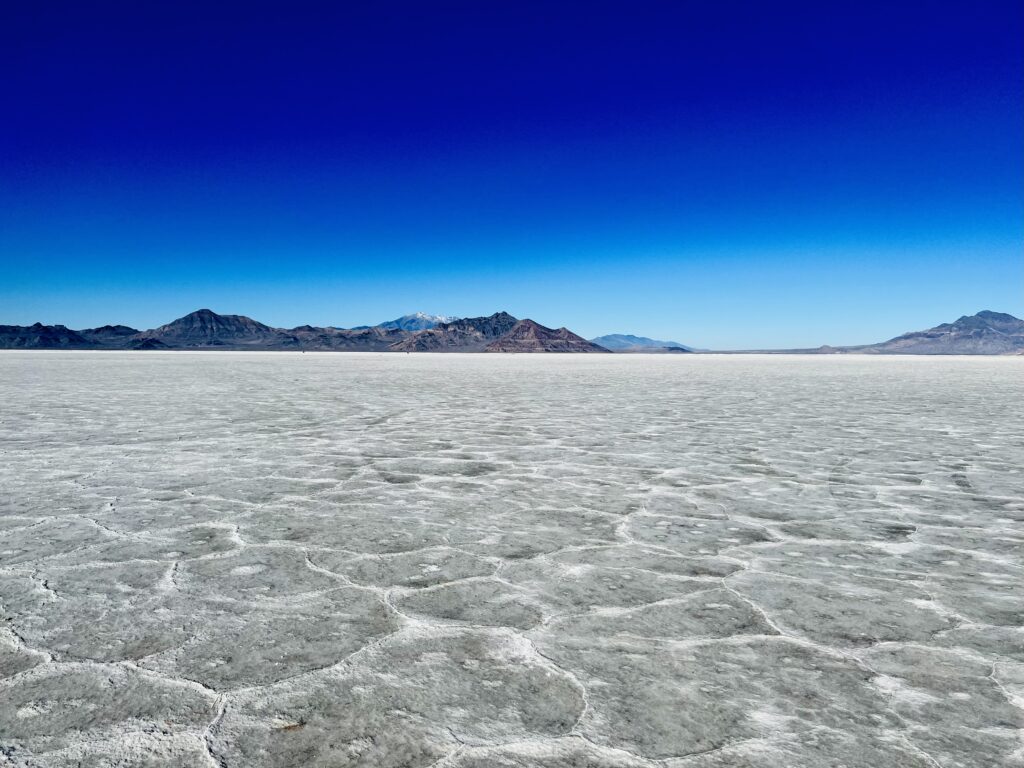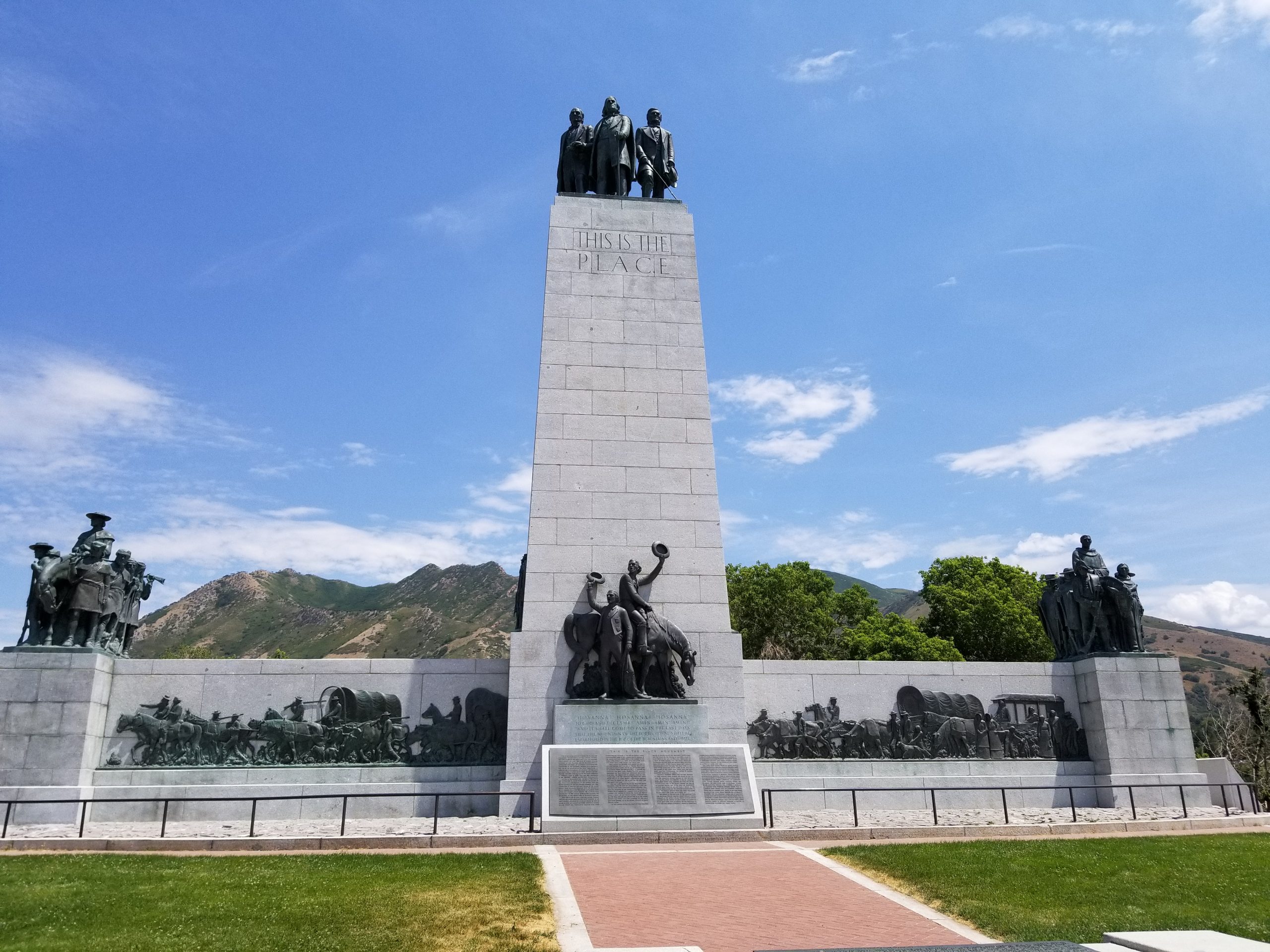Write-up by: John W. Henderson, Jr.
Placed by: Goodyear Tire & Rubber Company, June 1972
GPS Coordinates: 40.77953, -113.83226
Historical Marker Text:

WELCOME TO THE BONNEVILLE SALT FLATS
And Utah’s Famed Measured Mile – Site of World Land-Speed Record Runs
Utah’s famed measured mile is located approximately seven miles beyond this marker, well in front of the mountains you see on the horizon. The elevation along the course is approximately 4,218 feet above sea level. *** The total length of the course that includes the measured mile varies from year to year, but for recent runs it has been laid out in a path 80 feet wide and approximately ten miles long, with a black reference stripe down the middle. Due to the curvature of the earth, it is impossible to see from one end of the course to the other. *** Timing of world land-speed record runs is under the jurisdiction of the United States Automobile Club. World land-speed record times represent an electronically-timed average of two runs over the measured mile, within a one hour time period – one run in each direction. *** The first world land-speed record on the Bonneville Salt Flats was set on September 3, 1935, by Sir Malcolm Campbell. His speed was 301.13 miles per hour. *** Craig Breedlove holds the honor of being the first man to go faster than 400, 500, and 600 miles per hour. His record of 600.601 miles per hour, set on November 15, 1965, was finally broken on October 23, 1970, by Gary Gabelich. *** Gabelich’s new record is 622.407 miles per hour. Both Gabelich’s rocket engine ‘Blue Flame’ and Breedlove’s jet-powered ‘Spirit of America’ were equipped with specially designed inflatable tires, pre-tested to speeds in excess of 800 miles per hour.


Extended Research:
Known for hosting land-speed record attempts, the Bonneville Salt Flats are a geological and geographical wonder. Located near the shared border of Nevada and Utah in Tooele County, Utah and spanning 30,000 acres, this salt pan is a remnant of the ancient Lake Bonneville, which existed 32,000 to 14,000 years ago and was originally part of a larger body of water that existed during the geological Gelasian Stage of the Pleistocene Epoch, also known as the “Last Ice Age”.[1] Lake Bonneville covered an area of approximately 2,300 square miles and included the area now known as the Great Salt Lake and Great Salt Lake Desert.[2]
Euro-American explorers conducted reconnaissance of the area encompassing the Bonneville Salt Flat as early as 1833. Ordered by Captain Benjamin L.E. Bonneville, Pacific Coast explorer Joseph R. Walker may have encountered some of what remained of Lake Bonneville during his journey to California.[3] The Bartleson-Bidwell company, captained by John Bartleson and carrying the first white woman and child through Utah, would skirt the western edge of the desert on their way to California in 1841.[4] However, the first recorded crossing of the Great Salt Lake Desert region came 20 years later in 1845, when Captain John C. Fremont, accompanied by scouts Walker and Kit Carson, surveyed the area.[5]
Still, the Bonneville Salt Flats itself remained virtually untouched due to being too harsh an environment for early settlers and wagon trains passing thru to California. But western industrial development and modernization soon entered Tooele County: first, the permanent establishment of the telegraph in 1861; telephone services in 1905; and the first permanent crossing of the Bonneville Salt Flats by the Southern Pacific Railroad in 1910.[6] These developments gave rise to increased mining operations and travel through the county in the twentieth and twenty-first centuries.
The Bonneville Salt Flats may be known best for one reason: speed. In 1907, Bill Rishel began promoting the flats as a place for racers to drive their automobiles, following others’ attempts to set land-speed records in Paris, France and Daytona Beach, Florida. Although many initially refused the idea of racing on the flats, news of Utahn Ab Jenkins’ race against a locomotive train in 1925 and 24-hour endurance race in 1932 eventually spread, and in 1935, drivers from England arrived to break Jenkins’ records. In July 1935, John Cobb broke over 64 records on the flats, including Jenkins’ endurance record. In September 1935, Sir Malcolm Campbell, who had previously set the world land-speed record at Daytona Beach, broke his old record on the flats with a new land-speed record of 301.1202 miles per hour.[7] The race was on (so to speak) and the flats have seen racers come to be the new driver to best. The impacts of natural climate (i.e., wind, excess rain) and human events (i.e., commercial industries, interstate transportation) have been grounds for scientific and government concern. Increased temperatures, evaporation, and manmade boundaries have permanently affected the natural ecosystem and depleted the salt in and around the Bonneville Salt Flats, despite continued restoration efforts.[8] Several federal and local organizations, including the U.S. Bureau of Land Management, have joined forces to restore and preserve the flats.

[1] C. Claiborne Ray, “The Great Salt Flats,” New York Times (New York City, NY), November 30, 2004; Brenda B. Bowen, et al., “Temporal dynamics of flooding, evaporation, and desiccation cycles and observations of salt crust area change at the Bonneville Salt Flats, Utah, Geomorphology 299 (2017): 1; “GSA Geologic Time Scale,” Geological Society of America, updated August 2018.
[2] Ouida Blanthorn, Utah Centennial County History Series: A History of Tooele County (Salt Lake City: Tooele County Commission, Utah State Historical Society, 1998), 5.
[3] Blanthorn, A History of Tooele County, 48.
[4] Dean L. May, Utah: A People’s History (Salt Lake City: University of Utah Press, 1987), 50.
[5] Blanthorn, A History of Tooele County, 13.
[6] “The Bonneville Salt Flats,” Utah.com, accessed February 24, 2022.
[7] Jessie Embry and Ron Shook, “‘These Bloomin’ Salt Beds’: Racing on the Bonneville Salt Flats,” Utah Historical Quarterly 65, no. 4 (1997): 357.
[8] Bowen, “Temporal dynamics,” 10.
For Further Reference:
Primary Sources
“GSA Geologic Time Scale.” Geological Society of America. Updated August 2018.
Secondary Sources
Blanthorn, Ouida. Utah Centennial County History Series: A History of Tooele County. Salt Lake City: Tooele County Commission, Utah State Historical Society, 1998.
“The Bonneville Salt Flats.” Utah.com. Accessed February 24, 2022.
Bowen, Brenda B., Evan L. Kipnis, and Logan W. Raming. “Temporal dynamics of flooding, evaporation, and desiccation cycles and observations of salt crust area change at the Bonneville Salt Flats, Utah.” Geomorphology 299 (2017). Accessed February 24, 2022.
Carpenter, Glenn A. “The U.S. Bureau of Land Management’s Role in Resource Management of the Bonneville Salt Flats.” In Great Salt Lake: An Overview of Change, edited by J. Wallace Gwynn, 498-507. Salt Lake City: Salt Lake Field Office, Bureau of Land Management, 2002.
Embry, Jessie, and Ron Shook. “‘These Bloomin’ Salt Beds’: Racing on the Bonneville Salt Flats.” Utah Historical Quarterly 65, no. 4 (1997): 355-71.
Ray, Claiborne C. “The Great Salt Flats.” New York Times (New York City, NY), November 30, 2004.


Gabelich’s WORLD land speed record in The Blue Flame was 630.388 mph (FIA flying start kilometer).
The slower FIA mile flying start record, not the WORLD land speed record, was 622.407 mph.
Pingback: Bonneville Salt Flat Engagements | Niki Baldwin Photography | nikibaldwin.com